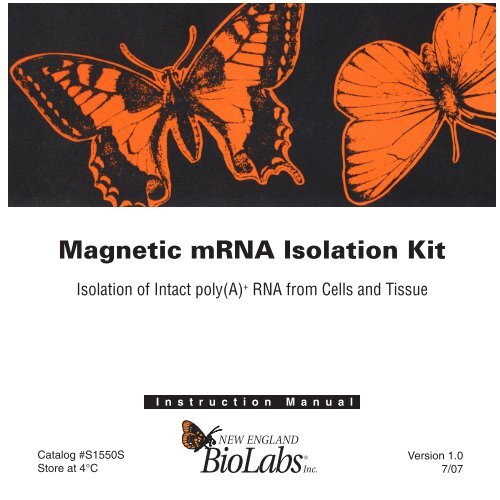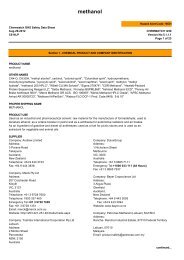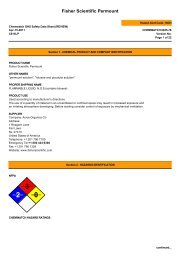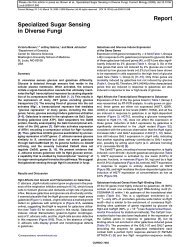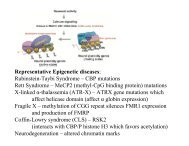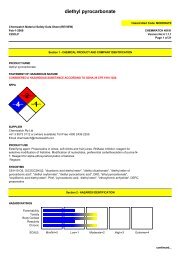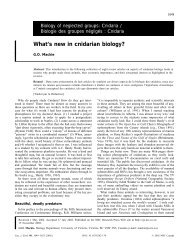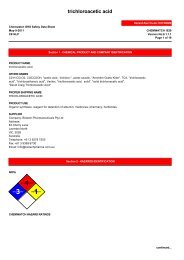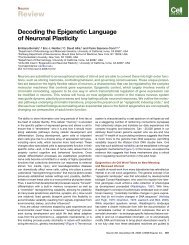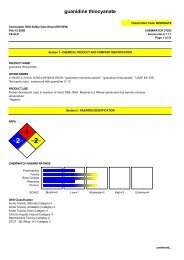manual Magnetic mRNA Isolation Kit S1550S
manual Magnetic mRNA Isolation Kit S1550S
manual Magnetic mRNA Isolation Kit S1550S
- No tags were found...
Create successful ePaper yourself
Turn your PDF publications into a flip-book with our unique Google optimized e-Paper software.
<strong>Isolation</strong> of <strong>mRNA</strong> from Mammalian Cells: Precautions should be taken to avoid ribonuclease contamination during the isolationprocedure. Clean the area where isolation will be performed with RNase decontaminationreagent before starting the isolation. Wear latex gloves or equivalent at all times when handling kit components.
TissueLysis/Binding BufferHomogenizationBindingOligo d(T) 25Beads1Wash BuffersDiscardSupernatants2Elution3Collect4Figure 1: Lysis and binding.Pure poly(A) + RNA
Table 1: Recommended Volumes for different <strong>Isolation</strong> Scales (for Cells)Volume of Volume of Volume ofNumber of Oligo d(T) 25Lysis/Binding Wash Buffers & Volume of ExpectedCells Beads Buffer Low Salt Buffer Elution Buffer Yield (µg)5 x 10 4 50 250 250 50 ~0.5–21 x 10 5 100 500 500 100 ~1–35 x 10 5 100 500 500 100 ~2–4Protocol:Step 1 Aliquot the appropriate volume of Oligo d(T) 25beads for the scale of isolation (Table 1).Add 200 µl of Lysis/Binding Buffer to beads, vortex briefly and mix with agitation for2 minutes. Beads should remain in the lysis/binding wash solution until removal immediatelybefore adding the cell lysate.Step 2 Adherent cells1. Aspirate media from cell culture plate and wash once with cold sterile1X PBS (pH 7.4).2. Add the appropriate volume of Lysis/Binding Buffer (Table 1) to cells andgently swirl by hand. Suspension cells1. Pellet cells by centrifuging at 1,000 rpm for 5 minutes at 4°C.2. Aspirate media and wash once with cold sterile 1X PBS (pH 7.4).3. Pellet again, discard PBS and add the appropriate volume of Lysis/Binding Buffer(Table 1) to cells.4. Agitate to suspend cells in Lysis/Binding Buffer.
Step 3Incubate at RT for 5 minutes with gentle agitation. If the solution is viscous, pass thelysate several times through a 21-gauge needle attached to a 1 or 2-ml syringe. Anoticeable decrease in viscosity should be observed.Place the microcentrifuge tube containing the beads and lysis/binding wash into the magneticrack and pull the magnetic beads to the side of the tube.Step 4 Remove Lysis/Binding wash and add the cell lysate to the equilibrated magnetic beads. Place cell lysate-and-bead suspension on the agitator and incubate at RT for 10 minutes. Place microcentrifuge tube into the magnetic rack and pull magnetic beads to the side ofthe tube, remove and discard supernatant.Step 5 Add the appropriate volume of Wash Buffer 1 (Table 1) to the beads and mix with agitationfor 1 minute. Place microcentrifuge tube into magnetic rack and pull magnetic beads to the side of thetube, remove and discard wash solution. Repeat once.
Step 6 Add the appropriate volume of Wash Buffer 2 (Table 1) to the beads and mix with agitationfor 1 minute. Place microcentrifuge tube into the magnetic rack and pull magnetic beads to the side ofthe tube, remove and discard wash solution. Repeat once.Step 7 Add the appropriate volume of Low Salt Buffer (Table 1) to the beads and mix with agitationfor 1 minute. Place microcentrifuge tube in the magnetic rack and pull magnetic beads to the side ofthe tube, remove and discard wash solution.Step 8 Add the appropriate volume of Elution Buffer (Table 1) and vortex gently to suspendbeads. Incubate at 50°C for 2 minutes with occasional agitation to elute poly(A) + RNA. >90% ofthe poly(A) + RNA bound to the beads is recovered in this step.Place microcentrifuge tube in the magnetic rack and pull the magnetic beads to the sideof the tube. Transfer eluent to a clean, sterile RNase-free tube and store on ice for immediatequantitation or place at –80°C for long-term storage.Quantitation of Isolated Poly(A) + RNA:Refer to page 14.
<strong>Isolation</strong> of <strong>mRNA</strong> from Tissue: Precautions should be taken to avoid ribonuclease contamination during isolation of theRNA. All materials used during the isolation procedure should be sterile and RNase-free. Clean the homogenizer with a NaOH based detergent and rinse with sterile RNase-freedeionized H 2O. Wear latex gloves or equivalent at all times when handling kit components. Reserve reagents exclusively for RNA work. If possible separate procedures such asplasmid preps which require the use of RNases from this work area. Increasing the amount of tissue sample beyond the recommended amount at a givenscale does not increase the yield of poly(A) + RNA isolated. More importantly, this willcause an increase the amount of tissue debris and ribonucleases present during theisolation.Table 2: Recommended <strong>Isolation</strong> Scale (for Tissue)Volume ofTissue (µg) Volume of Lysis/Binding Volume ofRNA Source per isolation Oligo d(T) 25beads Buffer wash buffersAnimal Tissue10 mg 100 µl 500 µl 500 µl20 mg 200 µl 500 µl 500 µl10
Protocol:Step 1 Aliquot the appropriate volume of Oligo d(T) 25beads for the scale of isolation (Table 2).Add 200 µl of Lysis/Binding Buffer to beads, vortex briefly and mix with agitation for2 minutes. Beads should remain in the lysis/binding wash solution until removal immediatelybefore adding the cell lysate.If tissue has been prepared beforehand and frozen, add Lysis/Binding directly to frozen tissuesample and proceed to Step 4, below.Step 2 Weigh fresh or frozen animal tissue as quickly as possible to avoid <strong>mRNA</strong> degradation. Place tissue into liquid nitrogen and grind immediately.Step 3 Transfer ground tissue to the Lysis/Binding Buffer and homogenizeusing brief 20-second pulses. If the solution is viscous, pass the lysate several times through a 21-gauge needle attachedto a 1 or 2 ml syringe. A noticeable decrease in viscosity should be observed.Step 4 Spin sheared lysate at 12,000 rpm, 4°C for 1 minute.Place the microcentrifuge tube containing the beads and lysis/binding wash into the magneticrack and pull the magnetic beads to the side of the tube, remove and discard the washsolution.11
Step 5 Decant tissue supernatant and add to previously washed Oligo d(T) 25beads. Placelysate-and-bead suspension on the agitator and incubate at RT for 10 minutes. Place microcentrifuge tube into the magnetic rack and pull magnetic beads to the side ofthe tube, remove and discard supernatant.Step 6 Add the appropriate volume of Wash Buffer 1 (Table 2) to the beads, vortex gently tosuspend beads. Incubate with agitation for 1 minute. Place microcentrifuge tube in the magnetic rack and pull magnetic beads to the side ofthe tube, remove and discard wash solution. Repeat once.Step 7 Add the appropriate amount of Wash Buffer 2 (Table 2) to the beads and mix with agitationfor 1 minute. Place microcentrifuge tube in the magnetic rack and pull magnetic beads to the side ofthe tube, remove and discard wash solution. Repeat once.Step 8 Add the appropriate volume of Low Salt Buffer (Table 2) to the beads and mix with agitationfor 1 minute. Place tube in magnetic rack and pull magnetic beads to the side of the tube, remove anddiscard wash solution.12
Step 9 Add 100 μl of Elution Buffer and vortex gently to suspend beads. Incubate at 50°C for 2 minutes with occasional agitation to elute poly(A) + RNA. >90% ofthe poly(A) + RNA bound to the beads is recovered in this step. Place microcentrifuge tube in magnetic rack and pull magnetic beads to the side of thetube. Transfer eluent to a clean, sterile RNase-free tube. Store on ice and immediately quantitateor place at –80°C for long-term storage.Quantitation of Isolated Poly(A) + RNA:Refer to page 14.13
Quantitation of Isolated Poly(A) + RNA:At this point quantification of isolated poly(A) + RNA can be done by measurement of theA 260absorbance using a Nanodrop spectrophotometer to avoid dilution of the sample. TheA 260/280ratio should be 1.6 or greater.The amount of isolated RNA will vary with the source of the RNA sample, typically for RNA1 A 260Unit = ~ 40 μg /ml.The eluted <strong>mRNA</strong> should be placed in the magnetic rack while removing aliquots for quantitationto avoid pipetting of beads, which will interfere with spectrophotometric analysis.Troubleshooting14Viscous lysateCertain cells lines and types of tissue will produce lysates that are more viscous thannormal. Pass these cell or tissue lysates several times through a 21-gauge needle.If sample lysate remains viscous after additional shearing, proceed with isolation.Poly(A) + RNA can be isolated under these conditions but is more likely to be contaminatedwith gDNA.Clumping of beadsIf lysate- bead- suspension clumps, rapidly pipette up and down with a 1 ml pipetmanto further reduce viscosity. Dilution with additional Lysis/Binding buffer will not reversethe clumping. Proceed with isolation, poly(A) + RNA of >60% purity can be isolatedunder these conditions.Genomic DNA ContaminationLower the ratio of cells or tissue to Lysis/Binding Buffer volume. Increase the bindingincubation time if the lysate remains viscous after additional shearing. If intended
downstream application requires <strong>mRNA</strong> be free of gDNA, a second round of isolationshould be done. See reuse of Oligo d(T) 25<strong>Magnetic</strong> Beads page 4.Low yield of <strong>mRNA</strong>Increase the ratio of beads to Lysis/Binding Buffer or add RNase-free Proteinase K tothe sample lysate directly before the 10 minute binding incubation.References:1. Wu, N. et al. (2004) Molecular Biotechnology, 27, 119–126.AppendixBuffer CompositionLysis/Binding Buffer: 20 mM Tris-HCl, pH 7.5, 500 mM LiCl, 0.5% LiDS,1 mM EDTA, 5 mM DTTWash Buffer I:Wash Buffer II:Low-Salt Buffer:Elution Buffer:20 mM Tris-HCl, pH 7.5, 500 mM LiCl, 0.1% LiDS,1 mM EDTA, 5 mM DTT20 mM Tris-HCl, pH 7.5, 500 mM LiCl, 1 mM EDTA.20 mM Tris-HCl, pH 7.5, 200 mM LiCl, 1 mM EDTA.20 mM Tris-HCl, pH 7.5, 1 mM EDTA.15
<strong>Kit</strong> Components Sold Separately:Oligo d(T) 25<strong>Magnetic</strong> Beads#S1419S25 mgCompanion Products:ProtoScript First-Strand cDNA Synthesis <strong>Kit</strong>#E6500SProtoScript II First-Strand cDNA Synthesis <strong>Kit</strong>#E6400SDyNAmo SYBR ® Green 2-Step qRT-PCR <strong>Kit</strong>#F-4306-Tube <strong>Magnetic</strong> Separation Rack#S1506S 6 tube capacity12-Tube <strong>Magnetic</strong> Separation Rack#S1509S 12 tube capacity16
USANew England Biolabs, Inc.240 County RoadIpswich, MA 01938Telephone (978) 927-5054Toll Free (USA Orders)1-800-632-5227Toll Free (USA Tech)1-800-632-7799Fax (978) 921-1350e-mail: info@neb.comwww.neb.comthe leader in enzyme technologyCanadaNew England Biolabs, Ltd.Telephone (905) 837-2234Toll Free 1-800-387-1095Fax (905) 837-2994Fax Toll Free 1-800-563-3789e-mail: info@ca.neb.comChinaNew England Biolabs (Beijing), Ltd.Telephone 010-82378266Fax 010-82378262e-mail: info@neb-china.comGermanyNew England Biolabs GmbHTelephone +49/(0)69/305 23140Free Call 0800/246 5227 (Germany)Fax +49/(0)69/305 23149Free Fax 0800/246 5229 (Germany)e-mail: info@de.neb.comJapanNew England Biolabs Japan, Inc.Telephone +81 (0)3 5669 6191Fax +81 (0)3 5669 6192e-mail: info@neb-japan.comUnited KingdomNew England Biolabs (UK) Ltd.Telephone (01462) 420616Call Free 0800 318486Fax (01462) 421057Fax Free 0800 435682e-mail: info@uk.neb.com


